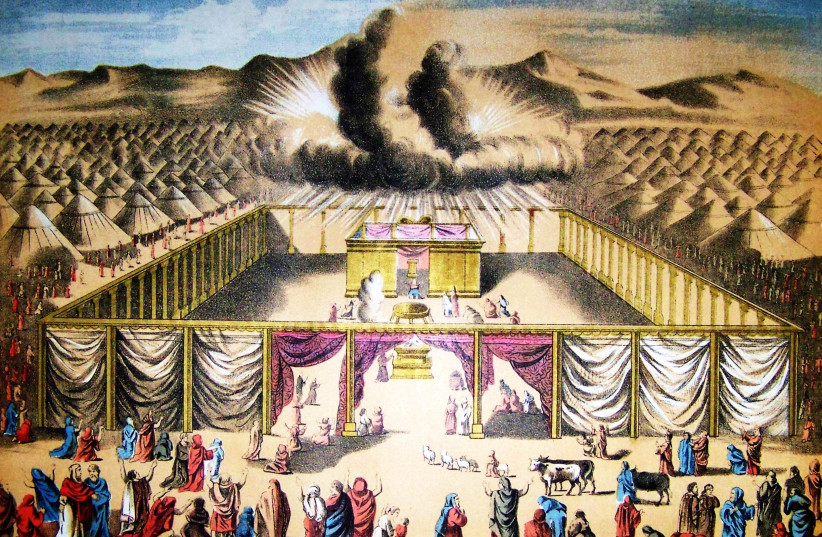“And you shall make an ark cover of pure gold. And you shall make two golden cherubim; you shall make them of hammered work, from the two ends of the ark cover… The cherubim shall spread their wings upward, shielding the cover with their wings” (Exodus 25:17-20).
In the heart of the Tabernacle (and of the Holy Temple) was the ark containing the tablets that were received on Mount Sinai. The ark’s cover was made entirely of gold, with a golden cherub at each end. These cherubim graced the cover of the ark in the Holy of Holies, with their wings facing each other and also facing the cover. As such, the cherubim are seen as guardians of the ark that holds the Torah, which is likened to a Tree of Life.
This is the second time cherubim are mentioned in the Torah. When Adam and Eve are expelled from Eden, cherubim guard the way to the Tree of Life with “the blade of the revolving sword.” The sword-wielding cherubim represent the loss of the connection with God, the expulsion from paradise. The cherubim guarding the ark signify a reconnection with God, the possibility of regaining paradise.
In the Garden of Eden, Adam and Eve heard the voice of God when they were strolling through the garden. After they were sent out, the cherubim blocked the way to the voice. In the Holy of Holies, man once again heard the voice of God, speaking to Moses from between the two cherubim (Exodus 25:22).
The cherubim on the ark had a dual purpose: to serve as a vehicle for that which is above; and to watch over that which is below. On the one hand, they were protectors of the ark, “sheltering the cover with their wings,” guarding it and the tablets of the covenant within. On the other hand, the “cherubim spread out their wings on high,” thus serving as a vehicle for godliness.

What are cherubim?
CHERUBIM ARE angels – messengers of God. As angels, they have many dimensions and are often clothed in a body of fire. Yoram Raanan’s painting Fiery Cherubim began as an experimental landscape. Over the canvas he spilled solid black paint to activate the landscape. Then, with his fingers, he added the fiery cherubim. The black comes through, giving a sense of wings and feathers.
There is a strong vertical movement upward, as the cherubim stretch their wings toward a world that lies beyond. They look like they are hovering, riding on guard. For Raanan, it is mysterious how the cherubim on the ark were inanimate, created by man, and yet they had a life of their own in the Temple. When we were serving God, the two cherubim would face each other; and when not, they would turn away from each other (Tractate Yoma 54a-b).
The cherubim are also woven into the fabric of the Tabernacle curtains and also of the parochet, the “veil” that divides the Holy of Holies from the rest of the Tabernacle. This fabric was to be woven of “blue, purple, and scarlet,” and the background colors of Raanan’s painting allude to the colors of the curtains.
The cherubim return in the prophecies of Ezekiel (Ezekiel 9:3-11:23), where they form the vehicle that conveys God’s presence away from the Temple in preparation for its destruction. Unfortunately, the Babylonians conquered Jerusalem and destroyed the city and the Temple. And yet, when all seemed lost, a remarkable thing happened.
The Talmud relates that when the Babylonian conquerors invaded the Temple grounds and entered the Holy of Holies, they were greeted by an amazing sight – the cherubim were embracing each other. Even in the worst of times, when there is no longer a Temple, God’s love for His people endures.
To this day, Jews continue to pray in the direction of the Temple Mount that was once the site of the Temple and the ark. When praying, says the Shulchan Aruch, the code of Jewish law, we should imagine ourselves standing before the Ark of the Covenant in the Holy of Holies. We pray that one day soon, the Temple will be rebuilt and the Ark of the Covenant restored, with its cherubim embracing once again, and forever.■
Meira Raanan is the author of Art of Revelation: A Visual Encounter with the Jewish Bible, a commentary on the paintings by her husband, Yoram Raanan. She also teaches Jewish meditation. Esther Cameron is a poet, scholar, and essayist living in Jerusalem. She is editor-in-chief of The Deronda Review.
